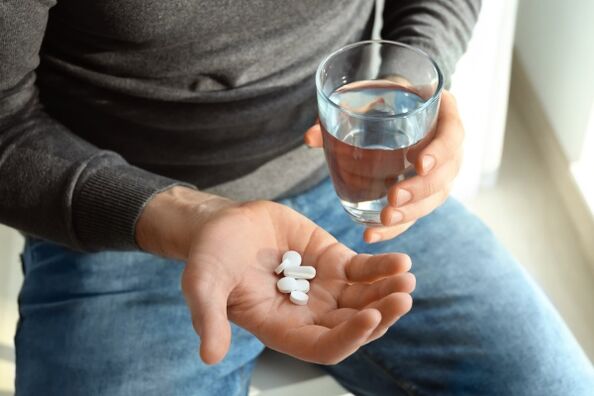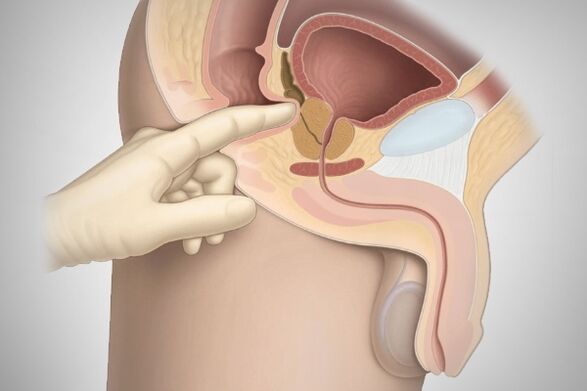Sometimes men face such an unpleasant disease as bacterial prostatitis. To start treatment on time, it is important to know what signs can diagnose the disease and what diagnosis and therapy will be needed.
Bacterial prostatitis is an infectious disease of the prostate gland. Symptoms of the disease include pain in the perineum, an increase in body temperature, intoxication of the body and other signs. Such a condition may require urgent hospitalization, as it may pose a threat to the patient's health and life.
Forms of bacterial prostatitis
Depending on the course and symptoms manifested, bacterial prostatitis is divided into two forms - acute and chronic.
Sharp
The acute form manifests itself suddenly and is accompanied by various unpleasant symptoms. The acute form of bacterial prostatitis requires immediate medical attention. This pathological process is provoked by Escherichia coli, staphylococci, enterobacteriaceae.
Acute prostatitis is easily diagnosed using laboratory tests. Severe symptoms and clinical picture allow an accurate diagnosis. Treat this form of prostatitis in a complex way using medication and physiotherapy.
chronic
Chronic bacterial prostatitis has a pathogenic pathogen that can be determined using tests and laboratory studies. The main pathogens are gonococci, chlamydia, ureaplasma, mycoplasma. The inflammatory process can also be caused by tuberculosis bacteria or fungi of the genus Candida, if the man has HIV infection.
Types of bacterial prostatitis
Bacterial prostatitis is classified according to the type of pathogen:
- tuberculosis (Koch bacilli);
- gonorrhea (gonococci);
- fungal (different types of fungi);
- chlamydial (chlamydia);
- viral (causative agents of herpes, human papillomavirus, influenza);
- mixed (several different infections).
It is possible to determine exactly what the causative agent was only under laboratory conditions, as the symptoms are the same for everyone.
Causes and risk factors
Bacteria enter the prostate gland, causing acute or chronic prostatitis. Sexually transmitted diseases can also cause this disease. In some cases, the cause cannot be determined.
Causing agentsbacterial prostatitis are considered:
- kolibacillus;
- klebsiella;
- Proteus;
- fecal enterococci;
- Pseudomonas aeruginosa.
Possiblemicrobiological reasonsprostatitis are:
- staphylococci (saprophytes, gold, epidermal);
- genital mycoplasma;
- chlamydia trachomatis;
- ureaplasma;
- Trichomonas.
P TORRisk factorsinfection of the prostate gland with the subsequent development of the inflammatory process in the form of one or another form of bacterial prostatitis are:
- intraprostatic reflux (reflux of urine into the ducts of the prostate gland during urination);
- pelvic damage;
- unprotected anal sex;
- urinary tract infections;
- having an urethral catheter or interrupted bladder catheterization;
- transurethral diagnostic and therapeutic interventions;
- HIV AIDS;
- past prostate biopsy.
Symptoms of bacterial prostatitis
Usually, with bacterial prostatitis, the symptoms are so pronounced that it is difficult not to pay attention to them. Signs of the disease include:
- high body temperature (in the anus is usually higher than in the armpit);
- fever and chills;
- difficult and painful urination, especially at night;
- possible development of constipation due to enlargement of the prostate gland;
- pain in the lower body (lower back, perineum, lower abdomen);
- general intoxication of the body;
- discharge from the urethra and blood into the semen.

Stages of bacterial prostatitis
The clinical picture of bacterial prostatitis is manifested depending on the stage of the disease and the degree of involvement of prostate tissue in the inflammatory process. Distribute:
- Primary or catarrhal prostatitis.It is characterized by inflammation of the walls of the prostate gland. Quite it is quite possible to cure with antibiotics in 10 days.
- Secondary or follicular.It is characterized by the formation of abscesses in the glandular tissue. It is associated with high temperature. This form is also effectively treated with antibacterial drugs.
- Tertiary or parenchymal.The pathological process at this stage extends throughout the organ - the prostate grows in size, swells and changes shape. If you do not receive timely treatment, then the tertiary phase can develop into chronic prostate.
Complications and possible consequences for men
Consequences and complications of bacterial prostatitis include:
- vesiculitis (inflammation of the seminal vesicles) - manifested by pain in the groin, premature ejaculation, painful erection;
- coliculitis (inflammation of the seminal tuberculosis) - varies in different symptoms - burning and tickling of the posterior urethra, painful sensations during orgasm, blood in the semen;
- breach of power;
- prostate sclerosis;
- infertility;
- prostate cyst;
- prostate abscess;
- stones in the prostate gland.
Chronic pelvic pain syndrome is one of the most serious consequences of chronic prostatitis.
Asymptomatic inflammation is the mildest form in terms of the absence of any complaints. This type of prostatitis is diagnosed with the development of complications from reproductive function.
Is bacterial prostatitis dangerous for women?
Prostatitis in women does not occur, but its serious consequences are common. If a man is affected by bacterial prostatitis, it is simply irresponsible to say that a woman is not at risk: chlamydia, ureaplasma, Trichomonas, mycoplasma, gonococcus, gardnerella and other infections received by her from a partner pose a serious risk to awoman and lead to the development of various gynecological diseases.
Which doctor is treating you?
Urologistis considered the leading specialist dealing with the diagnosis and treatment of pathological conditions of the genitourinary system.
Andrologist.Despite the fact that andrology belongs to a fairly new branch of medicine, specialists in this field are gradually taking their place in the treatment of diseases of the male genitourinary system. The advantage of this doctor is his narrow focus. Unlike a urologist who treats diseases of the male and female genitourinary system, the andrologist specializes exclusively in male problems.
Diagnosis of bacterial prostatitis
If a bacterial prostate is suspected, a number of tests are performed, including:
- scratches and swabs for infection;
- crops for sensitivity to flora and antibiotics;
- a general blood test helps detect the inflammatory process, when there is an increase in the number of leukocytes, an increase in ESR;
- spermogram, which examines a decrease in sperm count, a violation of their motility;
- three-glass urine sample (studies inflammatory changes in urine);
- general urine analysis;
- prostate secretion analysis;
- uroflowmetry - observation of the daily amount of urine.
The doctor will be able to estimate how much the prostate is enlarged by a digital examination of the rectum. To clarify the diagnosis, your doctor may refer you to a transrectal ultrasound scan.
Treatment of bacterial prostatitis
As therapy for bacterial prostatitis, medications, physiotherapy, folk remedies, and in severe cases, surgery are prescribed.
Drug treatment
Medical treatment of prostatitis is performed using different groups of drugs. These can be antibiotics to neutralize the pathogen. However, they do not always help, as the prostate gland is characterized by poor absorption of antibiotics from the group of protected penicillins, fluoroquinolones.
The course of treatment is usually 10-14 days and should be completed without fail, as if bacterial prostatitis is not treated, it will reappear. Vitamins and medicines are also prescribed to strengthen the immune system.

Surgical intervention
The doctor proposes prostate surgery if no results have been achieved in treating a patient with medication, physiotherapy or alternative treatment methods.
Surgical intervention includes the following procedures:
- Transurethral resection of the prostate.The inside of the organ is removed. Surgery is the most common and best endoscopic treatment for benign prostatic hyperplasia.
To perform this intervention, the patient takes a number of tests, including blood and urine tests. The operation is performed under spinal anesthesia, but general anesthesia can also be used. There are no wounds after the operation. Among the disadvantages is painful urination in the first days after the procedure. - Laser surgery.The laser destroys diseased tissue. At the same time, the size of the prostate decreases, and the vessels "seal" and no blood flows. The operation is performed without incisions, and the postoperative period is only three days. Blood and urine tests are performed before the intervention, as well as ultrasound of the urinary tract and, as prescribed by the doctor, a prostate biopsy is performed.
This method is not effective if the prostate volume is large. - Open prostatectomy.The operation is performed in cases when the prostate is greatly enlarged, in the presence of complications and in case of bladder damage.
The surgeon makes an incision either in the lower abdomen or between the scrotum and the anus. Either part of the prostate is removed, or it is completely.
Before surgery, ultrasound, MRI, and cytoscopy are performed, as well as blood and urine tests and a prostate-specific antigen test.
One of the advantages of surgery is its effectiveness in treating prostate and related problems. And from the disadvantages - a long recovery period after surgery (more than a month), as well as problems with erectile function. - Transurethral incision of the prostate gland.The doctor does not remove the prostate tissue, but only makes an incision to relieve pressure on the urethra, thus making urination easier. Before surgery, blood and urine tests are done, as well as an ultrasound of the urinary tract.
Advantages of the procedure - the symptoms of prostatitis are alleviated without the risk of retrograde ejaculation, long-term cure is not required. Of the shortcomings - prostatitis still needs to be treated. - Drainage of prostate abscess.The doctor opens the abscess through the perineum or rectum, cutting the skin and subcutaneous tissue and inserting a drain into the pus cavity for removal.
Before the operation, a consultation with a proctologist is performed, blood and urine tests are taken.
Advantages of surgery include the absence of the risk of losing sexual function. The disadvantages are that the abscess cannot be completely removed, and the bacteria can spread throughout the body.
Prostate surgery in men is usually the last resort for chronic bacterial prostatitis accompanied by complications of any form.
Physiotherapy
In the complex treatment of patients with a diagnosis of prostatitis, physical methods of influence are of great importance. As a result of physiotherapy procedures, these have improved:
- bleeding;
- lymphatic drainage, which contributes to the elimination of breakdown products of microorganisms;
- blood and lymph circulation, due to which inflammatory infiltrates are resolved;
- the outflow of blood and lymph, which helps reduce congestion in the pelvis;
- metabolism;
- activity of cell membranes, which promotes the penetration of active drugs into the cell.
Physiotherapy for bacterial prostatitis includes the following methods:
- Electrophoresis.Impact on the body with ions, which helps relieve inflammation and eliminate pain.
- Laser physiotherapy.The laser helps relieve perineal pain and improves blood circulation to the pelvic organs. It kills bacteria and removes waste products of harmful organisms.
- Magnetotherapy.When you perform this procedure, tissue permeability is improved and the effectiveness of drug therapy is significantly increased. Plus, with the help of magnetotherapy, hemodynamics and overload are stopped.
Exercise for bacterial prostatitis
Exercise for chronic prostatitis causes the muscles of the pelvic region to contract, which guarantees a change in intra-abdominal pressure. This stimulates blood circulation to the prostate. Exercise tones the nervous system, makes the adrenal glands function and removes the residual effects of inflammatory diseases in the prostate.
You can do the following exercises at home:
- The man sits on a rubber ball and rotates from left to right, releasing slightly. Helps strengthen pelvic floor and oblique muscles.
- Kegel Exercises. For 5-10 seconds, stretch your buttocks as much as possible, and then relax your muscles. This exercise is performed 20-50 times.
- Lying on your back, bend your knees and rest your heels on the floor. Slowly raise your pelvis by keeping your upper back flat on the floor. When the pelvis is at the top point, you should lift for 15 seconds, and then return to its original position. The number of repetitions is 10-15 times.
Performing a massage
To achieve the result, the exercises are done daily, and they are also supplemented with prostate massage, which can be performed both independently and with the help of special masseurs.
Prostate self-massage is performed as follows:
- Drink a liter of water an hour before the procedure to fill the bladder.
- Clean the intestines with an enema based on a solution of potassium permanganate or chamomile infusion. The face should be rinsed.
- Hands should be washed well and nails trimmed short.
- You need to put a glove or a condom on the finger to be used for massage.
- The rubber surface of the protective layer is lubricated with Vaseline, grease or baby cream.
- Lie down in a comfortable position and insert your finger into the anus to a depth of 5 cm.
- In the front wall, you can feel the prostate gland and start stimulating it with light strokes from the sides to the center.
- In difficult areas, the pressure gradually increases, and in soft areas, it decreases.
- In the final stage, striking movements are made down along the central groove.
- Gently pull the finger from the anus.

During the massage, 3-5 drops of liquid (prostate juice) should be released. Immediately after the massage, you should go to the toilet and empty the bladder.
Dietary therapy
With prostatitis, it is necessary to reduce the use of alcohol and cigarettes as much as possible. Doctors also recommend excluding from the diet:
- fatty foods, especially meat, as fat is a source of "bad" cholesterol, which disrupts blood circulation and adversely affects the prostate;
- energy and synthetic drinks;
- spices;
- spicy and smoky.
It is recommended to eat boiled and cooked food, lots of vegetables and herbs.
Folk remedies
Pumpkin seeds.Pumpkin seeds are an old remedy for prostatitis. They contain a lot of zinc, which the male body needs. You should eat 30 seeds a day before meals.
The branches of the hazelnut.Boil a few hazelnut twigs with leaves in water for 20 minutes, let cook until the soup takes on a reddish-brown color. For a cure, a weekly course is sufficient.
Leh Aspen.Aspen bark should be collected at the beginning of the fluid flow period, before the buds bloom. This is approximately the second half of April. Dry the peel in the oven, take 100 g, grind and place in a half-liter jar. Pour 200 g of vodka so that the rind is completely covered. Close the jar and place in a dark place for 2 weeks. Filter after 2 weeks. Take 1 teaspoon in three three-week courses with a 10-day break.
Prognosis for bacterial prostatitis
The prognosis for prostatitis of bacterial origin depends on the stage and type of the disease. The duration of the disease also affects the prognosis - the longer the inflammation persists, the longer it takes to treat prostate complications.
In acute prostatitis, the prognosis is favorable. Chronic bacterial prostatitis is often a recurrent form, even when conservative therapy is prescribed. With long-term treatment of the chronic form, changes in strength may occur.
Preventive measures
Prevention of bacterial prostatitis can be divided into primary and secondary.
Primary prevention of prostatitis:
- healthy lifestyle;
- good food;
- playing sports.
Preventive measures at home are important - performing exercises that activate blood flow to problematic organs and improve muscle tone.
Men should also study Kegel exercises. They were created for healing after giving birth to women, but they are used to train a man's anal muscles and rectum.
Gymnastic exercises are useful: bicycle, birch, bridge, candles. They train the pelvic floor muscles. It is recommended to perform leg swings, breathing exercises and take a contrast bath.
Secondary prevention of prostatitis:
- drug treatment;
- regular examination by a urologist, regardless of manifestations;
- within one year after treatment, undergo quarterly examinations, later - once every six months.
For secondary prevention, rectal suppositories are used. They act through the rectum. Usually, these drugs have few contraindications. Also, biologically active drugs are prescribed to prevent recurrence of bacterial prostatitis.
The sooner prostatitis is detected, the easier it is to cure. Therefore, do not neglect regular visits to the doctor. After the diagnosis, the doctor will choose the right medication and prescribe a therapeutic course. If the disease progresses, taking medication on time will quickly relieve symptoms and help you stay active and functional.































